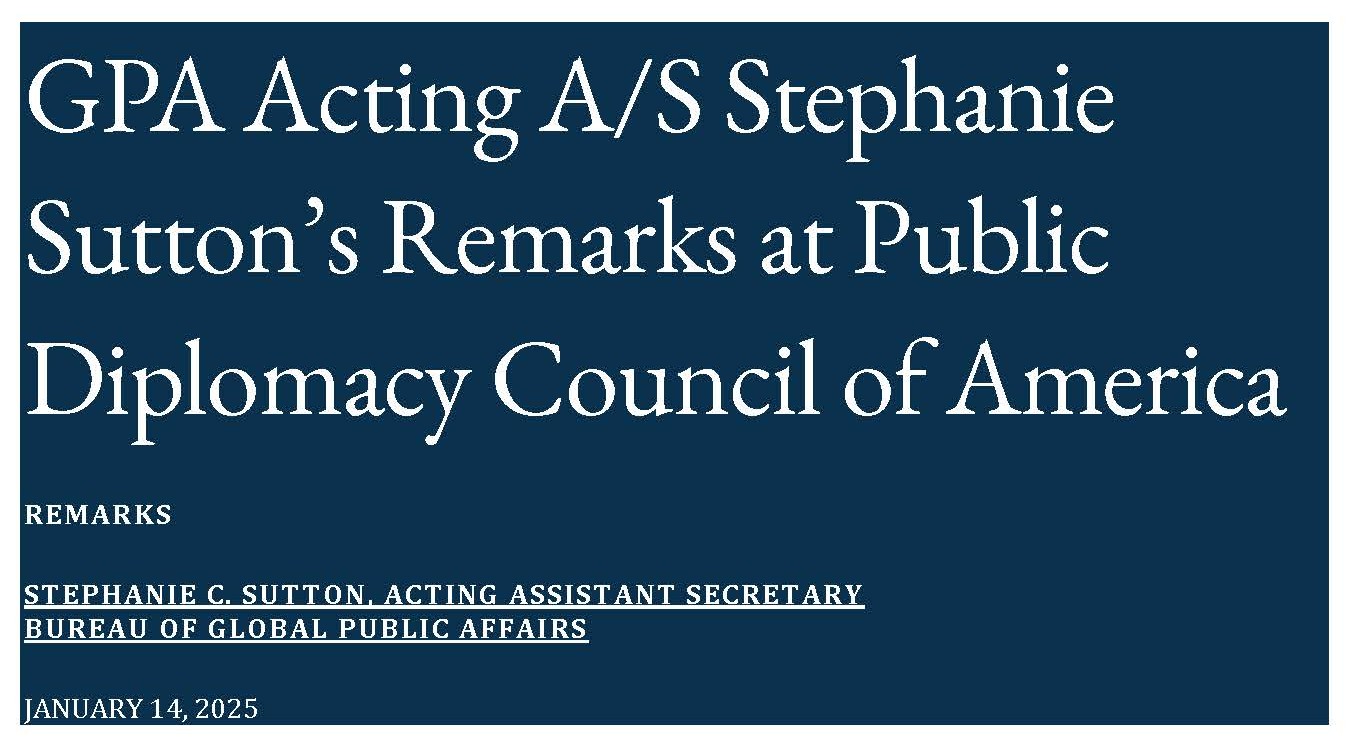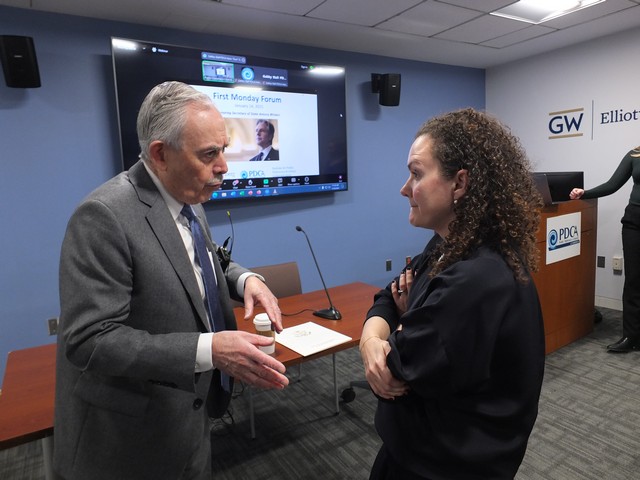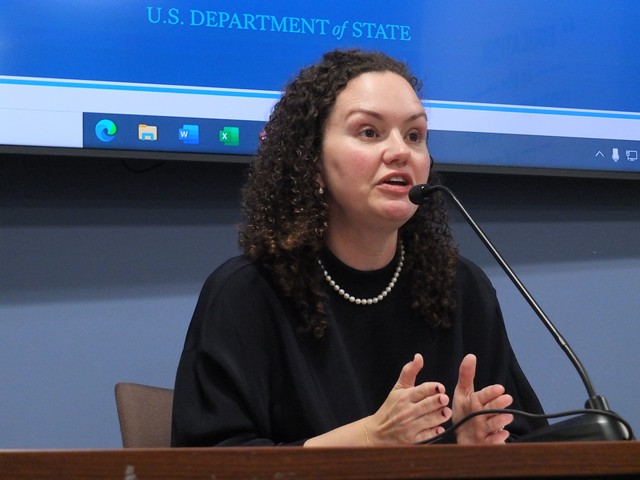GPA Acting A/S Stephanie Sutton’s Remarks at Public Diplomacy Council of America January 14, 2025

 As Prepared.
As Prepared.Thank you so much for having me today. It’s an honor to be here on behalf of Acting Undersecretary Satterfield, and I’m thrilled the Public Diplomacy Council of America (PDCA) is recognizing Secretary Blinken for his tremendous contributions to Public Diplomacy (PD) over the past four years.
From Day One, Secretary Blinken recognized PD as central to everything the State Department works to accomplish. A former journalist himself, the Secretary immediately reinstated the Department Press Briefing, our primary on-the-record platform for updates to news outlets, the public, and U.S. missions in the field on U.S. foreign policy priorities. Early on, he established an expectation that PD be – in his words – “at the takeoff and the landing” of any conversation. His conviction and sustained advocacy for PD as a central pillar of the Department’s funding requests meant our budgets remained relatively stable despite other cuts. He showed the centrality of PD, prioritizing people-to-people engagements and messaging opportunities during his travels. He met with members of our various “Y” (Youth Leaders) Networks; positioned cultural policy as security policy through cultural heritage, sports, and music; welcomed a record number of international students to the United States; and more. And today, there is broad recognition across the Department that PD – and, ideally, more of it – is critical to realizing policy goals.
 In a landmark speech in Seoul last March, Secretary Blinken recognized the necessity of PD in responding to the challenges of a crowded, complex, contested information environment — one in which state and non-state actors undermine objective truths on which open societies depend. He articulated how PD builds a healthier, more resilient information environment through both defensive and offensive approaches, leveraging cutting-edge technologies and new platforms, as well as more traditional PD tools such as English-language programs – which the Secretary has described as our best export – exchanges, and youth networks. In doing so, he placed PD – and, specifically, our Public Affairs Officers (PAOs) overseas – squarely at the center of owning this policy priority. As a result, and at his direction, PAOs have been empowered to lead interagency working groups designed to advance healthier information environments.
In a landmark speech in Seoul last March, Secretary Blinken recognized the necessity of PD in responding to the challenges of a crowded, complex, contested information environment — one in which state and non-state actors undermine objective truths on which open societies depend. He articulated how PD builds a healthier, more resilient information environment through both defensive and offensive approaches, leveraging cutting-edge technologies and new platforms, as well as more traditional PD tools such as English-language programs – which the Secretary has described as our best export – exchanges, and youth networks. In doing so, he placed PD – and, specifically, our Public Affairs Officers (PAOs) overseas – squarely at the center of owning this policy priority. As a result, and at his direction, PAOs have been empowered to lead interagency working groups designed to advance healthier information environments.Indeed, PD’s interagency leadership – and, in particular, coordination with our Department of Defense colleagues – has been a hallmark of Secretary Blinken’s tenure. For instance, last year – after lengthy negotiations led by our office of Policy, Planning, and Resources – Secretary of Defense Austin reinstated the requirement for Chief of Mission concurrence on certain information operations; now, PAOs are helping shape those and advising Chiefs of Mission. In addition, and building on a successful model at USINDOPACOM, we have invested in PD Liaison Officers at select geographic Combatant Commands to drive message alignment and maximize resources.
 Finally, under Secretary Blinken’s leadership, we have advanced a vision of modern PD – one that is audience-driven, data-informed, and policy-centric; prioritizes our people; and leverages emerging technologies. Through our Public Diplomacy Staffing Initiative (PDSI), we future-proofed our workforce, allowing us to reach audiences where they are, on the platforms most relevant to them, with messages and messengers that resonate. We secured the ability for PD teams to work with contractors to understand narratives on TikTok — increasingly a source of primary information for our key audiences overseas — and established an influencer team to maximize the reach of our messages. We strengthened our crisis planning and preparedness apparatus, ensuring PD equities are central to Department-wide conversations. Both American and local staff are offered training opportunities equipping them with the skills necessary to conduct modern PD, thanks to the Secretary’s culture of continuous learning. His embrace of emerging technologies led directly to the development of Northstar, our AI-enabled media analysis tool that has the potential to save 180,000 hours in staff time annually.
Finally, under Secretary Blinken’s leadership, we have advanced a vision of modern PD – one that is audience-driven, data-informed, and policy-centric; prioritizes our people; and leverages emerging technologies. Through our Public Diplomacy Staffing Initiative (PDSI), we future-proofed our workforce, allowing us to reach audiences where they are, on the platforms most relevant to them, with messages and messengers that resonate. We secured the ability for PD teams to work with contractors to understand narratives on TikTok — increasingly a source of primary information for our key audiences overseas — and established an influencer team to maximize the reach of our messages. We strengthened our crisis planning and preparedness apparatus, ensuring PD equities are central to Department-wide conversations. Both American and local staff are offered training opportunities equipping them with the skills necessary to conduct modern PD, thanks to the Secretary’s culture of continuous learning. His embrace of emerging technologies led directly to the development of Northstar, our AI-enabled media analysis tool that has the potential to save 180,000 hours in staff time annually.As we approach the presidential transition, I am proud we are passing the incoming administration a team equipped with the skills and tools to build trust with key audiences. On behalf of our 5,000-strong global PD workforce, thank you for the time – and thank you to Secretary Blinken for his leadership that brought us to this moment. I look forward to your questions.
(Photos courtesy of Bruce Guthrie. Included in the photos are Stephanie Sutton and PDCA President Joel Anthony Fischman)